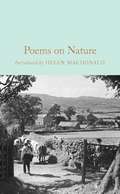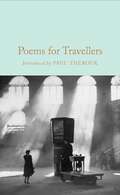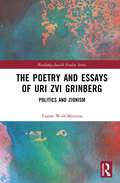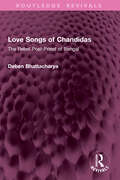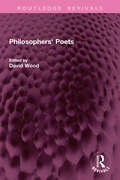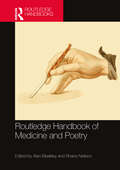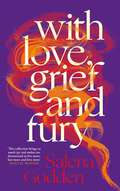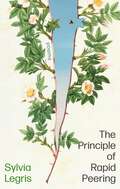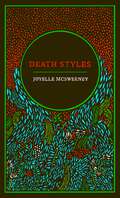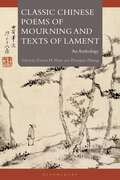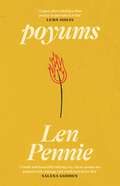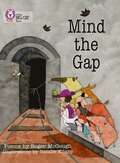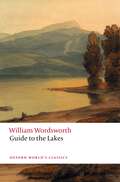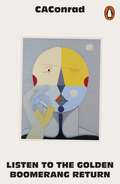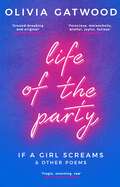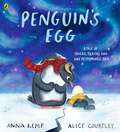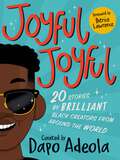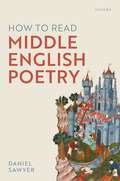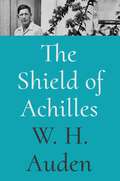- Table View
- List View
Poems on Nature (Macmillan Collector's Library #229)
by Gaby MorganThe poems in Poems on Nature are divided into spring, summer, autumn and winter to reflect in verse the changes of the seasons and the passing of time.Part of the Macmillan Collectors Library series, featuring expert introductions for your favourite classics. This edition features an introduction by Helen Macdonald, author of the international bestseller, H is for Hawk.Since poetry began, there have been poems about nature; it’s a complex subject which has inspired some of the most beautiful poetry ever written. Poets from Andrew Marvell to W. B. Yeats to Emily Brontë have sought to describe the natural environment and our relationship with it. There is also a rich tradition of songs and rhymes, such as ’Scarborough Fair’, that hark back to a rural way of life which may now be lost, but is brought back to life in the lyrical verses included in this collection.
Poems for Travellers (Macmillan Collector's Library #227)
by Gaby MorganPoems for Travellers transports the reader to lands far and near in the company of some of our greatest poets such as Walt Whitman, John Keats and Christina Rossetti.Part of the Macmillan Collectors Library series, featuring expert introductions for your favourite classics.As internationally acclaimed author Paul Theroux writes in his introduction, ‘Here is a collection of travel poetry composed by real travellers, weekending tourists, feverish fantasists, bluffers, dreamers, brave adventurers and resolute stay-at-homes. It succeeds in what poetry does best – inspires and consoles, reminds us of who we are, where we’ve been, and where we might want to go next.’
The Poetry and Essays of Uri Zvi Grinberg: Politics and Zionism (ISSN)
by Tamar Wolf-MonzonThis book focuses on the complex network of relationships between the poet Uri Zvi Grinberg and the Labor Movement in Mandate Palestine from 1923 to 1937.Making use of letters found in the Uri Zvi Grinberg Archive at the National Library of Israel (NLI), the author reconstructs the characteristics of Grinberg’s pioneer readership, attesting to their special relationship with his poetry. In the 1920s, it is argued, they considered Grinberg’s poetry an authentic expression of their complex spiritual world and especially of the reality of their lives. On his side, Grinberg accepted the pioneering ethos as the ideological basis of his works, becoming an outstanding poet of the Labor Movement. The chapters of this book track the various phases of Grinberg’s life and poetry, from his emigration to Palestine through to the 1930s, when he joined the Revisionist Movement and became increasingly ostracized from the Labor Movement. The story of Grinberg’s relations with the pioneers was emotionally charged—a mixture of enchantment and rejection, spiritual closeness and repulsion. Ultimately, this book analyzes the intensity of this connection and its many contradictory layers.This book will interest researchers in a range of fields, including Hebrew poetry and reception theory, as well as anyone interested in Israeli studies and the history of the Labor Movement in Palestine.
The Poetry and Essays of Uri Zvi Grinberg: Politics and Zionism (ISSN)
by Tamar Wolf-MonzonThis book focuses on the complex network of relationships between the poet Uri Zvi Grinberg and the Labor Movement in Mandate Palestine from 1923 to 1937.Making use of letters found in the Uri Zvi Grinberg Archive at the National Library of Israel (NLI), the author reconstructs the characteristics of Grinberg’s pioneer readership, attesting to their special relationship with his poetry. In the 1920s, it is argued, they considered Grinberg’s poetry an authentic expression of their complex spiritual world and especially of the reality of their lives. On his side, Grinberg accepted the pioneering ethos as the ideological basis of his works, becoming an outstanding poet of the Labor Movement. The chapters of this book track the various phases of Grinberg’s life and poetry, from his emigration to Palestine through to the 1930s, when he joined the Revisionist Movement and became increasingly ostracized from the Labor Movement. The story of Grinberg’s relations with the pioneers was emotionally charged—a mixture of enchantment and rejection, spiritual closeness and repulsion. Ultimately, this book analyzes the intensity of this connection and its many contradictory layers.This book will interest researchers in a range of fields, including Hebrew poetry and reception theory, as well as anyone interested in Israeli studies and the history of the Labor Movement in Palestine.
Love Songs of Chandidas: The Rebel Poet-Priest of Bengal (Routledge Revivals)
First published in 1967, Love Songs of Chandidās provides an informative introduction which makes vividly clear the importance of Chandidās to the Indian peasant masses. As the author tells us, the traveller through the Birbhum area of Bengal hears Chandidās everywhere, in the villages, in the fields, on the roads. Night after night, the people gather in the temple courtyards or on the village greens to listen to professional ‘Kirtan’ singers sing his songs of the divine love of Radha and Krishna. The influence of Chandidās on contemporary Bengali literature is equally important, his songs having enriched the work of great poets such as Rabindranath Tagore, Govindadas, and many others. The author also discusses the interesting topic of the Sahaja (‘spontaneity’) movement in Indian faith and literature, as manifested in the songs of Chandidās, and the worship of love-making, divine and human, as an important aspect of this faith. This book will be of interest to students of literature, music, history, cultural studies and South Asian studies.
Love Songs of Chandidas: The Rebel Poet-Priest of Bengal (Routledge Revivals)
by Deben BhattacharyaFirst published in 1967, Love Songs of Chandidās provides an informative introduction which makes vividly clear the importance of Chandidās to the Indian peasant masses. As the author tells us, the traveller through the Birbhum area of Bengal hears Chandidās everywhere, in the villages, in the fields, on the roads. Night after night, the people gather in the temple courtyards or on the village greens to listen to professional ‘Kirtan’ singers sing his songs of the divine love of Radha and Krishna. The influence of Chandidās on contemporary Bengali literature is equally important, his songs having enriched the work of great poets such as Rabindranath Tagore, Govindadas, and many others. The author also discusses the interesting topic of the Sahaja (‘spontaneity’) movement in Indian faith and literature, as manifested in the songs of Chandidās, and the worship of love-making, divine and human, as an important aspect of this faith. This book will be of interest to students of literature, music, history, cultural studies and South Asian studies.
Philosophers' Poets (Routledge Revivals)
First published in 1990, Philosophers’ Poets is a collection of case studies of philosophers’ readings of poets and other distinctive writers. There are those, for example, who find in literary examples ways of exploring the concrete significance of philosophical assertions or distinctions. Others find in poetic discourse linguistic resources simply not available to philosophy, yet of vital importance to it. This is particularly true of philosophers of the limit, such as Heidegger, Derrida, Levinas and Adorno, for whom the very possibility of philosophy was in question. Despite the diversity of subjects covered, the collection maintains an integrity and identity. Above all, it shows how contemporary Continental philosophy raises the issue of philosophy and literature anew in a way that is appealing and challenging.
Philosophers' Poets (Routledge Revivals)
by David WoodFirst published in 1990, Philosophers’ Poets is a collection of case studies of philosophers’ readings of poets and other distinctive writers. There are those, for example, who find in literary examples ways of exploring the concrete significance of philosophical assertions or distinctions. Others find in poetic discourse linguistic resources simply not available to philosophy, yet of vital importance to it. This is particularly true of philosophers of the limit, such as Heidegger, Derrida, Levinas and Adorno, for whom the very possibility of philosophy was in question. Despite the diversity of subjects covered, the collection maintains an integrity and identity. Above all, it shows how contemporary Continental philosophy raises the issue of philosophy and literature anew in a way that is appealing and challenging.
Routledge Handbook of Medicine and Poetry
by Alan Bleakley Shane NeilsonThe Routledge Handbook of Medicine and Poetry draws on an international selection of authors to ask what the cultures of poetry and medicine may gain from reciprocal critical engagement. The volume celebrates interdisciplinary inquiry, critique, and creative expansion with an emphasis upon amplifying provocative and marginalized voices.This carefully curated collection offers both historical context and future thinking from clinicians, poets, artists, humanities scholars, social scientists, and bio-scientists who collectively inquire into the nature of relationships between medicine and poetry. Importantly, these can be both productive and unproductive. How, for example, do poet-doctors reconcile the outwardly antithetical approaches of bio-scientific medicine and poetry in their daily work, where typically the former draws on technical language and associated thinking and the latter on metaphors? How does non-narrative lyrical poetry engage with narrative-based medicine? How do poets writing about medicine identify as patients? Central to the volume is the critical investigation of the consequences of varieties of medical pedagogy for clinical practice.Presenting a vision of how poetic thinking might form a medical ontology this thought-provoking book affords an essential resource for scholars and practitioners from across medicine, health and social care, medical education, the medical and health humanities, and literary studies.
Routledge Handbook of Medicine and Poetry
The Routledge Handbook of Medicine and Poetry draws on an international selection of authors to ask what the cultures of poetry and medicine may gain from reciprocal critical engagement. The volume celebrates interdisciplinary inquiry, critique, and creative expansion with an emphasis upon amplifying provocative and marginalized voices.This carefully curated collection offers both historical context and future thinking from clinicians, poets, artists, humanities scholars, social scientists, and bio-scientists who collectively inquire into the nature of relationships between medicine and poetry. Importantly, these can be both productive and unproductive. How, for example, do poet-doctors reconcile the outwardly antithetical approaches of bio-scientific medicine and poetry in their daily work, where typically the former draws on technical language and associated thinking and the latter on metaphors? How does non-narrative lyrical poetry engage with narrative-based medicine? How do poets writing about medicine identify as patients? Central to the volume is the critical investigation of the consequences of varieties of medical pedagogy for clinical practice.Presenting a vision of how poetic thinking might form a medical ontology this thought-provoking book affords an essential resource for scholars and practitioners from across medicine, health and social care, medical education, the medical and health humanities, and literary studies.
With Love, Grief and Fury
by Salena GoddenWith Love, Grief and Fury contains love poems, for people and the planet; grief poems brimming with compassion, sharing tears and mourning what was and contemplating what could be; and poems of fire and fury that will kick some ass, tell the truth and inspire change and hope. Over thirty years after she first stormed the UK poetry scene, the trailblazing and award-winning writer Salena Godden has produced her most audacious and definitive collection to date. Like a big sister’s arm around your shoulder, With Love, Grief and Fury is important and nourishing for the soul.
The Principle of Rapid Peering
by Sylvia LegrisSelf-seeding windis a wind of ever-replenishing breath.-from 'The Walk, or The Principle of Rapid Peering'The title of Sylvia Legris' melopoeic collection The Principle of Rapid Peering comes from a phrase the nineteenth-century ornithologist and field biologist Joseph Grinnell used to describe the feeding behaviour of certain birds. Rather than waiting passively for food to approach them, these birds live in a continuous mode of 'rapid peering'. Legris explores this rich theme of active observation through a spray of poems that together form a kind of almanac or naturalist's notebook in verse. Here is 'where nature converges with words,' as the poet walks through prairie habitats near her home in Saskatchewan, through lawless chronologies and mellifluous strophes of strobili and solstice. Moths appear frequently, as do birds and plants and larvae, all meticulously observed and documented with an oblique sense of the pandemic marking the seasons. Elements of weather, ornithology, entomology, and anatomy feed her condensed, inflective lines, making the heart bloom and the intellect dance.Features drawings by the poet.
Death Styles
by Joyelle McSweeney'McSweeney is one of our most dynamic poets' Nick Ropatrazone, The Millions'I've never read anything by Joyelle McSweeney that wasn't totally exciting' Dennis CooperOne of LitHub's Most Anticipated Books for 2024In this follow-up to her award-winning collection, Toxicon and Arachne, Joyelle McSweeney proposes a link between style and survival, even in the gravest of circumstances. Setting herself the task of writing a poem a day and accepting a single icon as her starting point, however unlikely - River Phoenix, Mary Magdalene, a backyard skunk - McSweeney follows each inspiration to the point of exhaustion and makes it through each difficult day. In frank, mesmeric lyrics, Death Styles navigates the opposing forces of survival and grief, finding a way to press against death's interface, to step the wrong way out of the grave.
Classic Chinese Poems of Mourning and Texts of Lament: An Anthology
Bathed with the blood and tears of countless poets and authors and naturally expressing the most heartfelt emotions of ancient peoples, poems of mourning and texts of lament stand out in classical Chinese literature as brilliant and unique. Composed and celebrated over 3000 years, they are central to the Chinese literary tradition but have been largely unknown to English readers. Including over 100 major pieces by leading literary figures from 800 BCE – 1800, this is the first English anthology of classic Chinese poems of mourning and texts of sacrificial offering. With annotated translations by leading scholars and reading guides accompanying each piece, this book reveals a powerful literary heritage to students and serious readers of Chinese literature, history and civilization.
Classic Chinese Poems of Mourning and Texts of Lament: An Anthology
by Victor H. Mair and Zhenjun ZhangBathed with the blood and tears of countless poets and authors and naturally expressing the most heartfelt emotions of ancient peoples, poems of mourning and texts of lament stand out in classical Chinese literature as brilliant and unique. Composed and celebrated over 3000 years, they are central to the Chinese literary tradition but have been largely unknown to English readers. Including over 100 major pieces by leading literary figures from 800 BCE – 1800, this is the first English anthology of classic Chinese poems of mourning and texts of sacrificial offering. With annotated translations by leading scholars and reading guides accompanying each piece, this book reveals a powerful literary heritage to students and serious readers of Chinese literature, history and civilization.
poyums
by Len PennieTHE INSTANT SUNDAY TIMES, THE TIMES, SUNDAY POST AND iPAPER BESTSELLER And I have done more than just simply get by So much more than escape or survive Through the galvanisation of love, time and patience I’ll take hold of my story and thrive. After life that was seldom what life ought to be Through laughter and love I’ll be whole This story is mine from the cover to spine And the narrative I will control Whether she’s writing letters to her younger self, advocating for women’s rights or adapting fairy tales to process an abusive relationship, Len’s voice is bold, unashamedly frank and unmistakably hers. The poems in this collection, both funny and fiercely feminist, announce a formidable new talent. Moving deftly between English and Scots, poyums is as approachable as it is affecting.
Guide to the Lakes: With Mr. Wordsworth's Description Of The Scenery Of The Country, Etc. And Five Letters On The Geology Of The Lake District (Oxford World's Classics)
by William WordsworthWilliam Wordsworth's Guide to the Lakes gives a first-hand account of his feelings about the unique countryside that was the source of his inspiration. He addresses concerns that are relevant today, such as how the growing number of visitors, and the money they might bring, would affect such a small and vulnerable landscape. It is now understood that Wordsworth's notion of the Lake District as 'a sort of national property, in which every man has a right and interest who has an eye to perceive and a heart to enjoy', expressed in his Guide, gave a rationale for the foundation of the National Trust in 1895 and the establishment of the Lake District National Park in 1951. Furthermore, the 2017 nomination document for the Lake District as a World Heritage site quotes this phrase in recognition of Wordsworth's contribution to the idea that 'landscape has a value, and that everyone has a right to appreciate and enjoy it'. We can now see how Wordsworth's Guide has had a far-reaching influence on the modern concept of legally-protected landscape. First published in 1810 and repeatedly revised by its author over the ensuing twenty-five years, William Wordsworth's Guide to the Lakes has long been considered a crucial text for scholars of Romantic-era aesthetics, ecology, travel writing, and tourism.
Listen to the Golden Boomerang Return
by CA ConradThe new collection from 'one of America's most legendary living poets' (Ocean Vuong), written in the drive to fall in love with the world again not as it was, but as it iswhen the hammerapproached we thought is that thing coming this wayBreathing, moving, living on the page, CAConrad’s exhilarating work is centred on the (Soma)tic ritual, their celebrated practice which draws on nature, crystals, meditation and interactions with strangers to create an ‘extreme present’ of unfettered creativity from which poems can emerge.Listen to the Golden Boomerang Return gathers the results of a single new ritual, focused on fellow animals who have found ways to thrive in the Anthropocene, and spanning environments from Seattle – a city built in the midst of an abundant nontropical rainforest – to the Mojave Desert. The poet receives gifts from a crow; associates different parts of their body with nine different species encountered in the desert; and joins a woman each morning in feeding rats in the streets of Rome, taking turns looking out for the police.Written with urgency, hope, anger and joy, the poems that result are an ode to survival in a world that humanity has poisoned, and a testament to a love that knows no by-laws.
Life of the Party: If A Girl Screams, and Other Poems
by Olivia Gatwood____________"I am stirred by the poems in this book - it is a sharp, unflinching collection of poems about girlhood, wonder, casual everyday violence."Yrsa Daley-Ward, author of 'bone' and 'The Terrible'In this multi-faceted collection of odes, anecdotes, sonnets and prose, Olivia Gatwood weaves together the trials and triumphs of growing up and explores the many ways that fear and violence can be internalized in a woman's psyche. At times blistering and riotous, at times soulful and exuberant, Life of the Party is about what it means to be a girl and a woman in today’s world and the challenge of briefly being both. In powerful, piercingly candid language, Gatwood asks: How does one grow from a girl to a woman in a world wracked by violence? What happens to our bodies that make us who we are? Is this fear really irrational?A dazzling collection of raw and explosive poems from a thrilling new feminist voice.
Penguin's Egg
by Anna KempOn a frozen sea, where the snow falls fast, and the whirlwinds rage and storm,A rockhopper egg, in a stony nest, was lying safe and warm.Dad watched and waited, waited, watched, the night grew inky black, Then he fell into a sleep so deep, he didn't hear the . . . CRACKDaddy Penguin finds himself adrift in an unfamiliar world, and he must get home for his egg!From train to helicopter, hot-air balloon to limousine, Daddy Penguin hitches lifts with kindly folk - but will he be home in time?A race against time for Daddy Penguin in this rhyming delight
Joyful, Joyful: Stories Celebrating Black Voices
by Adejoké Bakare"A wonderful collection of short stories and poems from 40 black writers and illustrators . . . Brilliantly curated by Dapo Adeola" - Joseph Coelho, Children's LaureateA hugely entertaining, fully colour-illustrated collection celebrating joy, perfect for children age 8 to 12 (and beyond!). Curated by Laugh Out Loud Awards winner Dapo Adeola, with a foreword by the acclaimed Patrice Lawrence. Joyful, Joyful is a book to sing about!Featuring both exciting new talents and globally renowned creators – every poem and story is individually illustrated by an amazing artist.With stories featuring a mythical whale, a message from the future, a Halloween dance competition, a talking book, a miraculous discovery in a moment of lost hope, the joy of jollof rice and so much more. The creators hail from around the world, from the UK and US, to Uganda, the Netherlands, Nigeria and more.Colourful and beautifully illustrated, with artwork from an array of talented illustrators including Ken Wilson Max, Dapo Adeola, Dorcas Magbadelo, Odera Igbokwe and Denzell Dankwah, alongside stories and poems by the likes of Malorie Blackman, Alex Wheatle, Faridah Àbíké-Íyímídé and Dorothy Koomson.Contributors include: Adejoké ‘Joké’ Bakare, Alex Wheatle, Arantza Peña Popo, Ashley Evans, Awuradwoa Afful, Camilla Sucre, Camryn Garrett, Charis JB, Dapo Adeola, Denzell Dankwah, Dorcas Magbadelo, Doreen Baingana, Dorothy Koomson, Faridah Àbíké-Íyímídé, Funmbi Omotayo, Hannah Lee, Jeffrey Boakye, Jess Nash, Kelechi Okafor, Ken Wilson-Max, Kofi Ofosu, Koleka Putuma, Maame Blue, Malorie Blackman, Matilda Feyisayo Ibini, Michael Kennedy, Nathan Bryon, Odera Igbokwe, Ojima Abalaka, Olu Oke, Patrice Lawrence, Rahana Dariah, Robyn Smith, Rosaline Tella, Sharna Jackson, Snalo Ngcaba, Terrence Adegbenle, Tomekah George, Tracey Baptiste, Trish Cooke, Yasmin Joseph and Zaïre Krieger.
How to Read Middle English Poetry
by Daniel SawyerHow to Read Middle English Poetry guides readers through poetry between 1150 and 1500, for study and pleasure. Chapters give down-to-earth advice on enjoying and analyzing each aspect of verse, from the choice of single words, through syntax, metre, rhyme, and stanza-design, up to the play of larger forms across whole poems. How to Read Middle English Poetry covers major figures?such as Chaucer, Langland, the Pearl Poet, and Robert Henryson?but also delves into exciting anonymous lyrics, romances, and drama. It shows, too, how some modern poets have drawn on earlier poems, and how Middle English and early Scots provide crucial standpoints from which to think through present-day writing. Contextual sections discuss how poetry was heard aloud, introduce manuscripts and editing, and lay out Middle English poetry's ties to other tongues, including French, Welsh, and Latin. Critical terms are highlighted and explained both in the main text and in a full indexed glossary, while the uses of key tools such as the Middle English Dictionary are described and modeled. References to accessible editions and electronic resources mean that the book needs no accompanying anthology. At once thorough, wide-ranging, and practical, How to Read Middle English Poetry is indispensable for students exploring Middle English or early Scots, and for anyone curious about the heart of poetry's history.
The Shield of Achilles (W. H. Auden: Critical Editions Ser. #1)
by W. H. AudenBack in print for the first time in decades, Auden&’s National Book Award–winning poetry collection, in a critical edition that introduces it to a new generation of readersThe Shield of Achilles, which won the National Book Award in 1956, may well be W. H. Auden&’s most important, intricately designed, and unified book of poetry. In addition to its famous title poem, which reimagines Achilles&’s shield for the modern age, when war and heroism have changed beyond recognition, the book also includes two sequences—&“Bucolics&” and &“Horae Canonicae&”—that Auden believed to be among his most significant work. Featuring an authoritative text and an introduction and notes by Alan Jacobs, this volume brings Auden&’s collection back into print for the first time in decades and offers the only critical edition of the work.As Jacobs writes in the introduction, Auden&’s collection &“is the boldest and most intellectually assured work of his career, an achievement that has not been sufficiently acknowledged.&” Describing the book&’s formal qualities and careful structure, Jacobs shows why The Shield of Achilles should be seen as one of Auden&’s most central poetic statements—a richly imaginative, beautifully envisioned account of what it means to live, as human beings do, simultaneously in nature and in history.
How to Read Middle English Poetry
by Daniel SawyerHow to Read Middle English Poetry guides readers through poetry between 1150 and 1500, for study and pleasure. Chapters give down-to-earth advice on enjoying and analyzing each aspect of verse, from the choice of single words, through syntax, metre, rhyme, and stanza-design, up to the play of larger forms across whole poems. How to Read Middle English Poetry covers major figures?such as Chaucer, Langland, the Pearl Poet, and Robert Henryson?but also delves into exciting anonymous lyrics, romances, and drama. It shows, too, how some modern poets have drawn on earlier poems, and how Middle English and early Scots provide crucial standpoints from which to think through present-day writing. Contextual sections discuss how poetry was heard aloud, introduce manuscripts and editing, and lay out Middle English poetry's ties to other tongues, including French, Welsh, and Latin. Critical terms are highlighted and explained both in the main text and in a full indexed glossary, while the uses of key tools such as the Middle English Dictionary are described and modeled. References to accessible editions and electronic resources mean that the book needs no accompanying anthology. At once thorough, wide-ranging, and practical, How to Read Middle English Poetry is indispensable for students exploring Middle English or early Scots, and for anyone curious about the heart of poetry's history.
